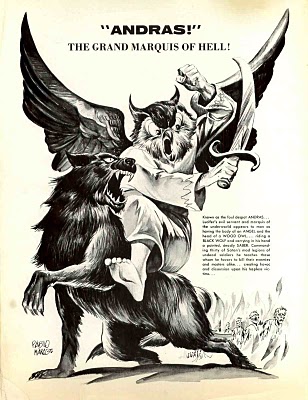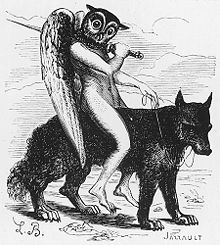|
|

Andras |
|
Marquis AndrasSigurd (Sig) Stromgard was pursued by and fought the demon Andras in the novel Wizard's Sword. A thumbnail sketch of Andras' characteristics can be found below.Andras[1] is a Great Marquis of Hell, having under his command thirty legions of demons. He sows discord among people.
Andras was considered to be a highly dangerous demon, who could
kill the conjuring magician
and his assistants if precautions were not taken. A misstep
outside the magical protective circle could mean instant death
for the conjurer(s), The Dutch demonologist Johannes Wier[3], in his Pseudomonarchia Daemonum, says of Andras: "Andras is a great marquesse, and seemes in an angels shape with a head like a blacke night raven, riding upon a blacke and a verie strong woolfe, flourishing with a sharpe sword in his hand, he can kill the maister, the servant, and all assistants, he is author of discords, and ruleth thirtie legions."
"Grand Marquis of Hell. He appears to have the body of an angel and the head of a wood owl, and to be riding a black wolf and carrying in his hand a pointed saber. He teaches those whom he favors to kill their enemies, masters and servants. He stirs up trouble and dissension. He commands thirty legions." |
||
| [1] Mathers, S. L. MacGregor; Crowley, A. (1995)
[1893], The Goetia: The Lesser Key of Solomon the King, ISBN
087728847X, OCLC 9032192 (Full text)
[2] The Lesser Key of Solomon or Clavicula Salomonis (the Clavis Salomonis, or Key of Solomon is an earlier book on the subject), is an anonymous 17th-century grimoire, and one of the most popular books of demonology. It has also long been widely known as the Lemegeton. The book claims that it was originally written by King Solomon, although this is certainly incorrect. The titles of nobility (such as the French Marquis or Germanic Earl) assigned to the demons were not in use in his time, nor were the prayers to Jesus and the Christian Trinity included in the text (Solomon's birth predated Jesus Christ's birth by more than 900 years). [3] Johann Weyer (in Dutch Jan/Johan/Johannes Wier, in Latin Ioannes Wierus and Piscinarius), (1515, Grave - 24 February 1588) was a Dutch physician, occultist and demonologist, disciple and follower of Heinrich Cornelius Agrippa. He was among the first to publish against the persecution of witches. His most influential work is De Praestigiis Daemonum et Incantationibus ac Venificiis (On the Illusions of the Demons and on Spells and Poisons, 1563). |
||
| Web Design by Mike Lance | ||

 According
to the
According
to the and Andras was always trying to lure them out.
and Andras was always trying to lure them out. Another
demonologist,
Another
demonologist,